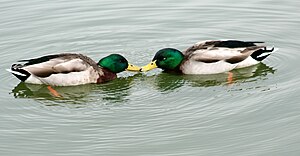
Back المثلية الجنسية في الحيوان Arabic Homosexualidá n'animales AST Gaweng homosekswal sa mga hayop BCL Cyfunrywioldeb mewn anifeiliaid Welsh Homoseksualitet blandt dyr Danish Homosexuelles Verhalten bei Tieren German Samseksemo ĉe bestoj Esperanto Comportamiento homosexual en animales Spanish Loomade homoseksuaalne käitumine Estonian رفتار همجنسگرایانه در جانوران Persian

Various non-human animal species exhibit behavior that can be interpreted as homosexual or bisexual, often referred to as same-sex sexual behavior (SSSB) by scientists. This may include same-sex sexual activity, courtship, affection, pair bonding, and parenting among same-sex animal pairs.[1][2][3] Various forms of this are found among a variety of vertebrate and arthropod taxonomic classes. The sexual behavior of non-human animals takes many different forms, even within the same species, though homosexual behavior is best known from social species.
Scientists observe same-sex sexual behavior in animals in different degrees and forms among different species and clades. A 2019 paper states that it has been observed in over 1,500 species.[4] Although same-sex interactions involving genital contact have been reported in many animal species, they are routinely manifested in only a few, including humans.[5] Other than humans, the only known species to exhibit exclusive homosexual orientation is the domesticated sheep (Ovis aries), involving about 10% of males.[6][7][8] The motivations for and implications of these behaviors are often lensed through anthropocentric thinking; Bruce Bagemihl states that any hypothesis is "necessarily an account of human interpretations of these phenomena".[9]: 2
Proposed causes for same-sex sexual behavior vary across species. Theories include mistaken identity (especially for arthropods), sexually antagonistic selection, balancing selection, practice of behaviors needed for reproduction, expression of social dominance or submission, and social bonding.[10] Genetic, hormonal, and neurological variations as a basis for individual behavioral differences within species have been proposed, and same-sex sexual behavior has been induced in laboratory animals by these means.
- ^ Braithwaite, L. W. (1981). "Ecological studies of the Black Swan III – Behaviour and social organization". Wildlife Research. 8. Canberra, Australia: CSIRO: 134–146. doi:10.1071/WR9810135.
- ^ Bailey, N. W.; Zuk, M. (August 2009). "Same-sex sexual behavior and evolution". Trends in Ecology and Evolution. 24 (8): 439–46. doi:10.1016/j.tree.2009.03.014. PMID 19539396.
- ^ "Same-sex Behavior Seen In Nearly All Animals, Review Finds". ScienceDaily (Press release). 17 June 2009.
- ^ Monk, Julia D.; Giglio, Erin; Kamath, Ambika; Lambert, Max R.; McDonough, Caitlin E. (December 2019). "An alternative hypothesis for the evolution of same-sex sexual behaviour in animals". Nature Ecology and Evolution. 3 (12): 1622–1631. Bibcode:2019NatEE...3.1622M. doi:10.1038/s41559-019-1019-7. ISSN 2397-334X. PMID 31740842. S2CID 256708244.
- ^ Bailey JM, Vasey PL, Diamond LM, Breedlove SM, Vilain E, Epprecht M (September 2016). "Sexual Orientation, Controversy, and Science". Psychological Science in the Public Interest. 17 (2): 45–101. doi:10.1177/1529100616637616. PMID 27113562. S2CID 42281410.
- ^ Poiani A, Dixson AF (2010). Animal Homosexuality: A Biosocial Perspective. Cambridge University Press. p. 179. ISBN 9781139490382.
This makes O. aries (ram) only the second mammal known, apart from humans, capable of displaying exclusive homosexuality.
- ^ Levay S (2017). Gay, Straight, and The Reason Why: The Science of Sexual Orientation (Second ed.). Cambridge, Massachusetts: Oxford University Press. pp. 38, 119. ISBN 978-0-19-029737-4 – via Google Books.
- ^ Raymond, Michel; Crochet, Pierre-André (October 2023). "Carving Non-Proximal Explanations for Same-Sex Sexual Orientation". Archives of Sexual Behavior. 52 (7): 3007–3012. doi:10.1007/s10508-022-02497-z.
There are numerous reports of homosexual behavior in many animal species in the wild, but there are no reports of exclusive same-sex sexual orientation (Bagemihl, 2000). It is, however, well-established that some domestic rams exhibit exclusive same-sex sexual orientation.
- ^ Bagemihl B (1999). Biological Exuberance: Animal Homosexuality and Natural Diversity (Stone Wall Inn ed.). New York City: St. Martin's Press. ISBN 9780312253776 – via Internet Archive.
- ^ Balfour, Vicki L.; Shuker, David M. (November 2020). "Same-sex sexual behaviour". Current Biology. 30 (22): R1345–R1346. doi:10.1016/j.cub.2020.09.005. Retrieved 25 June 2024.
© MMXXIII Rich X Search. We shall prevail. All rights reserved. Rich X Search